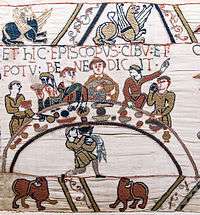Roger de Beaumont
Roger de Beaumont (c. 1015 – 29 November 1094), feudal lord (French: seigneur) of Beaumont-le-Roger and of Pont-Audemer in Normandy, was a powerful Norman nobleman and close advisor to William the Conqueror.

−

Origins
He was a son of Humphrey de Vieilles (who was a great-nephew of the Duchess Gunnor of Normandy) by his wife Albreda de la Haye Auberie. Roger de Beaumont was thus a second cousin once removed of William the Conqueror. His Norman feudal lordship had its caput and castle at Beaumont-le-Roger, a settlement situated on the upper reaches of the River Risle, in Normandy, about 46 km SW of Rouen, the capital of the Duchy. He was also feudal lord of Pont-Audemer, a settlement built around the first bridge to cross the River Risle upstream of its estuary, shared with the River Seine.
Physical appearance
Roger was nicknamed La Barbe (Latinised to Barbatus) (i.e. "The Bearded").
Career
Planché described him as "the noblest, the wealthiest, and the most valiant seigneur of Normandy, and the greatest and most trusted friend of the Danish (i.e., Norman) family". The explanation for his exalted position appears to be that as an older cousin who had never rebelled against the young Duke, he was part of the kinship group of noblemen that William relied upon in governing Normandy and fighting-off frequent rebellion and invasions. The historian Frank McLynn observed that William relied heavily on relatives on his mother's side, namely his half-brothers Bishop Odo and Robert, and brothers-in-law, and on relatives descended from the Duchess Gunnor's sisters, since his own paternal kin had proved unreliable.
Wace, the 12th-century historian, wrote that: "At the time of the invasion of England, Roger was summoned to the great council at Lillebonne, on account of his wisdom; but he did not join in the expedition as he was too far advanced in years". Although Roger could not fight, he did not hesitate in contributing a large share of the cost, and provided at his own expense sixty vessels for the conveyance of the troops across the channel. Furthermore, his eldest son and heir fought bravely at Hastings as noted in several contemporary records. As a result, Roger's elder sons were rewarded generously with lands in England, and both eventually were made English earls by the sons of the Conqueror. Wace's statement may therefore cast doubt on the possibility of Roger being depicted in the Bayeux Tapestry feasting at Hastings. However it is possible that he crossed the Channel so he could continue to act as a valued member of the Duke's council, perhaps giving advice on military tactics, yet stayed well behind the line of battle at headquarters.
Marriage and children
He married circa 1048 or earlier Adeline of Meulan (c. 1014-1020 - 8 April 1081), who was buried at the Abbaye du Bec, the daughter of Waleran III, Count de Meulan by Oda de Conteville, and sister and heiress of a childless Count of Meulan. Meulan eventually passed to their elder son who became Count of Meulan in 1081. Their surviving children were:
- Robert de Beaumont, 1st Earl of Leicester, Count of Meulan (c.1049-1118), the eldest son and heir. He succeeded his father in the major part of his lands, and was one of the few proven companions of William the Conqueror who fought at the Battle of Hastings in 1066.
- Henry de Beaumont, 1st Earl of Warwick (c.1050-1119). He was overshadowed by his elder brother, but was granted by his father one of his lesser lordships in Normandy, the lordship of Le Neubourg, about 12 km NE of Beaumont-le-Roger, from which his own family adopted the surname Anglicised to "de Newburgh". He established a more enduring line of Beaumont earls than his elder brother, Earls of Warwick seated at Warwick Castle.
- William de Beaumont (not mentioned in most sources).
- Alberée de Beaumont (died 1112), Abbess of Eton.
Death and burial
He was buried at Abbey of Saint-Pierre de Préaux.
Sources
- Edward T. Beaumont, J.P. The Beaumonts in History. A.D. 850-1850. Oxford.
- J.R. Planché. The Conqueror and His Companions. London: Tinsley Brothers, 1874.
References
- Zouche, Lucy la (May 22, 2019). "Beaumont Crusaders and Campaigners". Lulu.com – via Google Books.